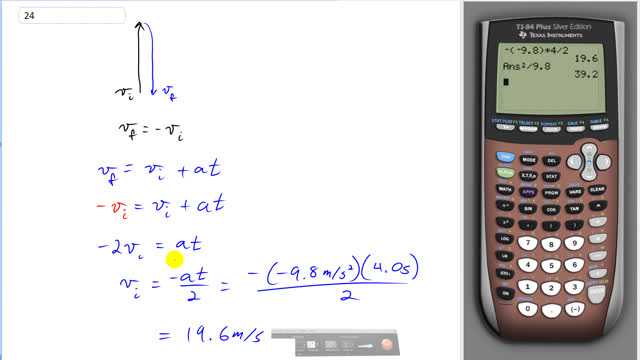
You buy a plastic dart gun, and being a clever physics student you decide to do a quick calculation to find its maximum horizontal range. You shoot the gun straight up, and it takes 4.0 s for the dart to land back at the barrel. What is the maximum horizontal range of your gun?

In order to watch this solution you need to have a subscription.
This is Giancoli Answers with Mr. Dychko. Our first job is to figure out the muzzle velocity of this dart gun, the speed at which the dart leaves the muzzle of the dart gun, and then once we know that, we'll use the handy range formula to figure out what the maximum range will be. So first thing you need to understand is that the final velocity when the dart goes back to the gun is gonna be the negative of its initial velocity so this projectile motion is symmetrical, you say, when we are neglecting air resistance. And so the speed that it has going up at this height is gonna be the same as the speed that it has coming down but the velocities will be just negative of each other, that's what this says. So when we use this formula for saying final velocity is initial velocity plus acceleration times time, we can substitute negative v i in place of v f and then we'll subtract v i from both sides and we get negative 2v i on the left equals at then divide both sides by negative 2 and we get this initial velocity then of the dart from the barrel of the dart gun is negative of negative of 9.8 meters per second squared times 4 seconds for it to complete its full path up, and down, and divide by 2 and that gives 19.6 meters per second and then we use the handy range formula. Now it may not be clear what to substitute in for Θ but it's actually not important the only thing that's important to know is that sin of anything will have a maximum of 1; no matter what number you plug in here, the sin of it will never exceed the number 1. And I have put in a graph of sin of x and we have x going from negative 180 up to 360 so no matter what angle you choose I guess I could have gone just from 0 to 90 because those are the only angles you'll ever be able to shoot with using a dart gun and when you trace this, you will see that the function goes from 0 up to a maximum of 1; before I had this at negative 180 which is kind of neat so let's take a look at that up to 360 sin goes from negative 1 up to 1 the range of this function is negative 1 to 1 and I'm using the word range there in a mathematical sense in that it's the full set of numbers in the y-coordinates, it goes from 1 to negative 1, anyway. So when we go left and right here, you can see that this y-value is decreasing and has a maximum of 1 when x is 90 so you can make this thing here 90 in which case Θ is 45 because 2 times 45 would make that whole thing 90 or you can just say, well, I know something about the sin function the sin has a maximum of 1 and so it is 1. When we want to find R max, it's always gonna be initial velocity squared divided by g. So that's 19.6 meters per second all squared divided by 9.8 meters per second squared is 39 meters is the maximum range with this dart gun and that's two significant figures since our time had two significant figures.
amazing
Thanks!
I have some arguments from trigonometry students and their teacher reasoning that for #24 (chapter 3) the answer would be 0. I know this text states on page 63 that Sin2theta is 1 but their reasoning being supported by the calculator is convincing. Would you be able to give more insight to this question?
Thank you.
Hi cmorales, thank you for your question. The textbook question asks "What is the maximum horizontal range of your gun?". The gun is able to shoot, since we're given data about how long a shot straight up takes to return to the gun. This data is useful to determine the initial velocity that's possible for the gun. With that initial velocity in mind, we can calculate the maximum possible range, and it will certainly be more than zero. The angle at which the range is maximum is , and taking the sine of two times that gives "one", which is the greatest possible sine value of any angle. Keep in mind that we're maximizing horizontal range, not vertical height... I'm just guessing at where the misunderstanding might be...